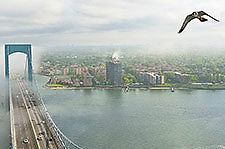A peregrine falcon soars above New York City's Verrazano-Narrows Bridge. MTA/Patric Cashin
A few years ago in Baltimore County, Maryland, environmental staffers were reviewing a tree-planting proposal from a local citizens group. It called for five trees each of 13 different species, as if in an arboretum, on the grounds of an elementary school in a densely-populated neighborhood.
It seemed like a worthy plan, both for the volunteer effort and the intended environmental and beautification benefits. Then someone pointed out that there were hardly any oaks on the list, even though the 22 oak species native to the area are known to be wildlife-friendly. Local foresters, much less local wildlife, could barely recognize some of the species that were being proposed instead. As if to drive home the logical inconsistencies, both the school and the neighborhood were named after oak trees.
“Why are we doing this?” someone wondered.
That sort of epiphany has been happening a lot lately in metropolitan areas around the world, as people come to terms with both the dramatic increase in urbanized areas and the corresponding loss of wildlife. The portion of the planet characterized as urban is on track to triple from 2000 to 2030—that is, we are already almost halfway there. Meanwhile, 17 percent of the 800 or so North American bird species are in decline, and all 20 species on the Audubon Society’s list of “common birds in decline” have lost at least half their population since 1970.
Those kinds of stark numbers, repeated around the world, have made it disturbingly evident that it’s not enough for cities to plant a million trees, preach the gospel of backyard gardens, or build green roofs and smart streets. The trees, shrubs, and flowers in that ostensibly green infrastructure also need to benefit birds, butterflies, and other animals. They need to provide habitat for breeding, shelter, and food. Where possible, the habitat needs to be arranged in corridors where wildlife can safely travel.
Though it may be too soon to call it an urban wildlife movement, initiatives focused on urban biodiversity seem to be catching on. The U.S. Forest Service, which once laughed off the idea that anything urban could be wild, now supports a growing urban forest program. Urban ecology and urban wildlife programs are also proliferating on university campuses. There’s a “Nature of Cities” blog, launched in 2012. University of Virginia researchers recently announced the beginning of a Biophilic Cities Network devoted to integrating the natural world into urban life, with Singapore, Oslo, and Phoenix among the founding partners.
Source: Conniff, R. 2014. Urban Nature: How to Foster Biodiversity in World's Cities. Yale Environment 360.
